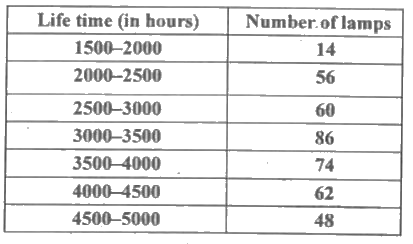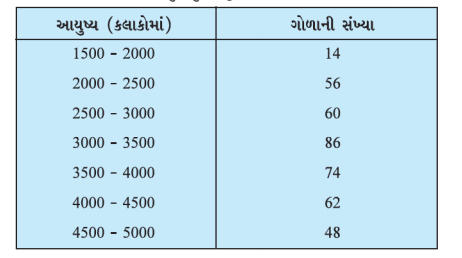The following table gives the distribution of the lifetime of 400 neon lamps :
Lifetime (in hours) Number of lamps 1500−2000 14 2000−2500 56 2500−3000 60 3000−3500 86 3500−4000 74 4000−4500 62 4500−5000 48
Find the median of a lamp. Solution in Gujrati
Step by step video & image solution for The following table gives the distribution of the lifetime of 400 neon lamps : {:("Lifetime (in hours) ","Number of lamps "),(" "1500-2000," "14),(" "2000-2500," "56),(" "2500-3000," "60),(" "3000-3500," "86),(" "3500-4000," "74),(" "4000-4500," "62),(" "4500-5000," "48):} Find the median of a lamp. by Maths experts to help you in doubts & scoring excellent marks in Class 9 exams.
Updated on:21/07/2023Topper's Solved these Questions
- STATISTICSBOOK - KUMAR PRAKASHANCHAPTER - STATISTICSEXERCISE - EXERCISE 14.4
6 Videos
- STATISTICSBOOK - KUMAR PRAKASHANCHAPTER - STATISTICSEXERCISE - SUM TO ENRICH REMEMBER
14 Videos
- STATISTICSBOOK - KUMAR PRAKASHANCHAPTER - STATISTICSEXERCISE - EXERCISE 14.2
9 Videos
- QUESTION PAPER 3 : FOR THE ANNUAL EXAMINATION BOOK - KUMAR PRAKASHANCHAPTER - QUESTION PAPER 3 : FOR THE ANNUAL EXAMINATION EXERCISE - SECTION -D
5 Videos
- SURFACE AREAS AND VOLUMESBOOK - KUMAR PRAKASHANCHAPTER - SURFACE AREAS AND VOLUMESEXERCISE - MULTIPLE CHOICE QUESTIONS
18 Videos
Similar Questions
The following number of goals were scored by a team in a series of 10 matches : 2, 3, 4, 5, 0, 1, 3, 3, 4, 3 Find the mean, median and mode of these scores.
View SolutionConsider the marks obtained by 10 students in a mathematics test as given below: 55 36 95 73 60 42 25 78 75 62 Find the range of the data.
View SolutionThe blood groups of 30 students of Class VIII are recorded as follows: A, B, O, O, AB, O, A, O, B, A, O, B, A, O, O, A, AB, O, A, A, O, O, AB, B, A, O, B, A, B, O. Represent this data in the form of a frequency distribution table. Which is the most common, and which is the rarest, blood group among these students ?
View SolutionProve that the angles opposite to equal sides of an isosceles triangle are equal.
View SolutionThe total surface area of a cuboid with length 20 cm, breadth 15 cm and height 10 cm is ……… cm2.
View SolutionThe following table gives the distribution of the life time of 400 neon lamps Find the median life of a lamp.
View SolutionThe following table gives the distribution of the life time of 400 neon lamps: Lite time: (in hours) Number of lamps 1500-2000 14 2000-2500 56 2500-3000 60 3000-3500 86 3500-4000 74 4000-4500 62 4500-5000 48 Find the median life.
View SolutionThe following table gives the life time of 400 neon lamps: Life time (in hours 300-400 400-500 500-600 600-700 700-800 800-900 900-1000 No. of lamps: 14 56 60 86 74 62 48 A bulb is selected at random. Find the probability that the life time of the selected bulb is : less than 400 between 300 to 800 hours at least 700 hours.
View SolutionThe price of 357 mangoes is Rs. 1517.25. What will be the approximate price of 49 dozens of such mangoes? Rs.3000 b. Rs.4000 c. Rs.3500 d. Rs.2500
View SolutionThe following table gives the lifetimes of 400 neon lamps

(i) Represent the given information with the help of a histogram.
(ii) How many lamps have a lifetime of more 700 h?
View SolutionThe following table gives the distribution of the life - time of 400 neon lamps.
Lif time (in hours)Number of lamps1500−2000142000−2500562500−3000603000−3500863500−4000744000−4500624500−500048
Find the median life -time of a lamp .
View SolutionThe following table gives the distribution of the life time of 400 neon lamps :

Find the median life time of a lamp
View SolutionThe following table gives the distribution of the life-time of 400 neon lamps

Find the median life time of a lamp.
View SolutionThe following table gives the distribution of the life-time of 400 neon lamps

Find the median life time of a lamp.
View SolutionThe following table gives the distribution of income of 100 families in a village. Calculate the standard deviation: Income Rs. 0-1000 1000-2000 2000-3000 3000-4000 4000-5000 5000-6000 No. of Families 18 26 30 12 10 4
View SolutionThe following table gives the distribution of income of 100 families in a village. Calculate the standard deviation: Income Rs., 0-1000, 1000-2000, 2000-3000, 3000-4000, 4000-5000, 5000-6000 No. of Families, 18, 26, 30, 12, 10, 4
View Solution
